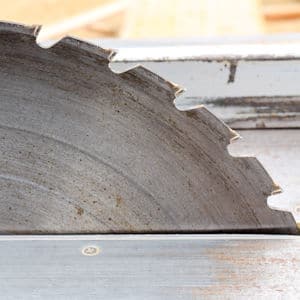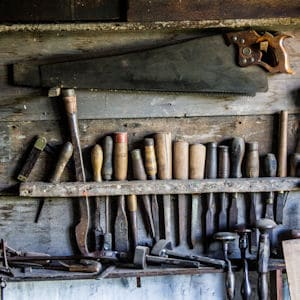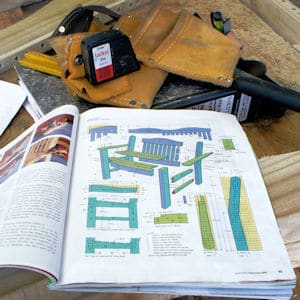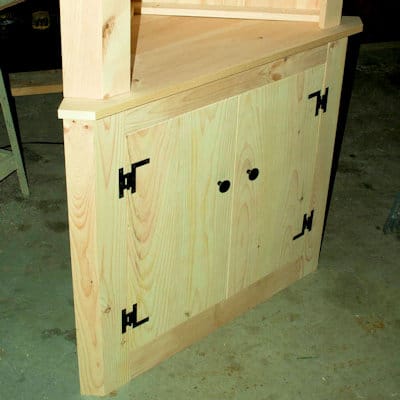
We Know Wood Tools
Welcome to Tool & Bark, your source for information on all manner of ways of working with wood, from sawing firewood to planing lumber, and from sanding a shelf to staining a deck. Whether you need to prune your hedge, clear your campsite, or turn a table leg – we have you covered. Tool & Bark offers general information on various tools that work on wood operate, so that you understand the advantages of different methods and technologies. And we provide detailed tool and wood product reviews and comparisons, so that you can make an informed decision when you decide to purchase.
Cutting Tools

A Table Saw Blade
Both electric chainsaws and gas powered chainsaws are excellent tools for cutting down trees (and electric chainsaw sharpeners keep them cutting fast), while limbers and hedge trimmers are great at dealing with branches. Firewood racks are great for stacking all the wood you cut and split (try an electric log splitter if you want to save your back). A good chop saw or mitre saw< - especially one with a laser guide - will make sure you are nice and consistent when cutting studs and planks. Radial arms saws serve a similar function, and a circular saw is easy carry around the job site. Chainsaw mills allow you to mill your own lumber directly from felled trees. And a wood chipper shredder will allow you to process leftover branches into mulch.
And that is just scratching the surface – scroll saws and band saws allow you to cut out patterns and shapes, and jigsaws perform similar functions. Comparing wood lathes is important if you are planning to do projects that require turning wood. Thickness planers are great for getting your wood uniform. And let’s not forget the table saw – indispensable for ripping planks and cutting sheets of plywood. We cover these cutting tools and more, to help you understand the specialties of each, and which models rise above their peers.
Hand Tools

Vintage Hand Tools
Axes and buck saws for chopping and dropping trees, hatchets and hand saws for similar jobs on a smaller scale. An adze is good for rough shaping larger pieces of wood, while mallets and hammers can help put things in place.
Then there are tools like chisels and hand planers for shaping wooden projects, and coping saws and mitre saws for close precision. Rasps and good old sandpaper are useful for making rough wood smooth. A good benchtop drum sander or belt sander can do it much faster. But for larger area work you might want a deck sander. Whatever your need, if you have a love of working with your hands on wood, we cover the tools you will need in your workshop.
Wood Construction

Rough lumber building
Some of them are power tools, like framing nailers and screw guns. Other tools – like levels, squares, stud finders, pliers and plumb bobs – perform crucial functions for carpenters and builders who work with wood. Countless structures have been built with hammer and nails, using wood measured by a tape and cut with a handsaw.
Of course, having straight, flat wood makes all the difference in the world when it comes to building with wood. That is why tools like jointer planer combo machines can move your product from the rough to finished categories.
Sure, there are lots of fancy time-saving tools on the market. But with some jobs old-school methods, simple tools, and manual labor get the project built. Some tools, while not used directly on wood, still have a place in other parts of typical construction. For instance, electric demolition hammers are often used to remove concrete before new wood construction begins. And the best portable workbench can be useful on almost any job.
And we don’t look at just tools – we also discuss other hardware used in wood construction projects, like in our review of barn door hardware kits. We also help you find the right gear for your wood shop, like in our review of the best dust collectors.
Wood Finishing

A corner cabinet project
Hardwoods like oak have different uses. Their durability make them perfect for beautiful flooring, and furniture and cabinets made from oak are universally sought after. In today’s world of disposable products, handcrafted hardwood furniture and floors dated in centuries give testimony to the value of building with wood.
Cedar has almost too many uses to count. Posts and shingles made from this wondrous wood stand up to damp environments without rotting, making it great for sheathing your house or putting up a fence. Inside a cedar closet or chest will keep your clothes smelling fresh and help keep away moths.
Redwood makes a great deck (just make sure you apply a semi-transparent deck stain or deck sealer on it), and is also frequently employed to make outdoor play sets. Spruce tops are favored by many instrument makers, and are especially good on fine guitars. When paired with mahogany or rosewood backs and sides and ebony fret boards, fine woods and craftsmanship can make wood sing.
And that is just to mention a few frequently used woods. There are so many varieties to work with – ash, birch, cherry, maple, teak – the types and specialties go on and on. And at Tool & Bark we are passionate about them all.